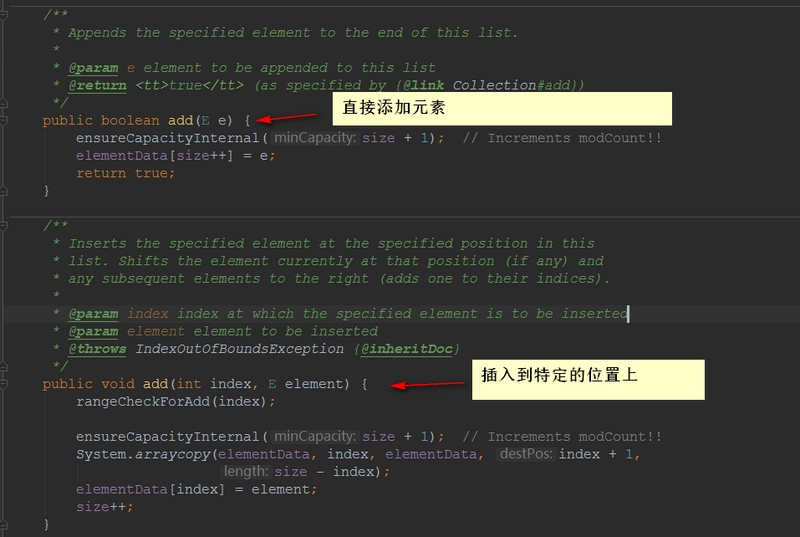List集合下的三个子类
1)ArrayList:底层结构式数组,线程不安全。
2)LinkedList:底层结构式链表,线程不安全。
3)Vector:底层结构式数组,线程安全。


ArrayList解析

1)ArrayList的属性

ArrayList底层结构就是一个数组,ArrayList能自动扩容,能够实现动态增长。
2)构造方法

3)Add方法

4)Add(E e)
- 检查是否需要扩容
- 插入元素
public boolean add(E e) { ensureCapacityInternal(size + 1); // Increments modCount!! elementData[size++] = e; return true; }
- 确认list容量,尝试容量加1,检查是否扩容
- 添加元素




add(E e)首先检查容量是否足够,如果足够,则直接添加;反之,扩容到原来的1.5倍,或者当容量还是小于minCapacity时,那就将容量扩充为minCapacity。
5)Add(int index,E element)
- 检查角标
- 空间检查,如果需要进行扩容
- 插入元素

与扩容相关ArrayList的add方法底层其实就是arraycopy()来实现的。

6)get方法
- 检查角标
- 返回元素

// 检查角标 private void rangeCheck(int index) { if (index >= size) throw new IndexOutOfBoundsException(outOfBoundsMsg(index)); } // 返回元素 E elementData(int index) { return (E) elementData[index]; }
7)set方法
- 检查角标
- 替代元素
- 返回旧值

8)remove方法
- 检查角标
- 删除元素
- 计算出需要移动的个数,并移动
- 设置为null,让GC回收

- ArrayList是基于动态数组实现的,在增删时候,需要数组的拷贝复制。
- ArrayList的默认初始化容量是10,每次扩容时候增加原先容量的一半,也就是变为原来的1.5倍
- 删除元素时不会减少容量,若希望减少容量则调用trimToSize()
- 它不是线程安全的。它能存放null值。
Vector与ArrayList的区别
Vector的底层也是数组,与ArrayList最大的区别就是:同步(线程安全)

在要求非同步的情况下,一般使用ArrayList。如果ArrayList要实现同步,可以使用Collections的方法:List list=Collections.synchronizedList(new ArrayList());就可以实现同步了。
ArrayList在底层数组不够用时在原来的基础上扩展0.5倍,Vector是扩展1倍。

LinkedList解析

LinkedList底层是双向链表。

LinkedList变量就几个

1)构造方法

常用的几个方法
/** * Links e as first element. */ private void linkFirst(E e) { final Node<E> f = first; final Node<E> newNode = new Node<>(null, e, f); first = newNode; if (f == null) last = newNode; else f.prev = newNode; size++; modCount++; } /** * Links e as last element. */ void linkLast(E e) { final Node<E> l = last; final Node<E> newNode = new Node<>(l, e, null); last = newNode; if (l == null) first = newNode; else l.next = newNode; size++; modCount++; } /** * Inserts element e before non-null Node succ. */ void linkBefore(E e, Node<E> succ) { // assert succ != null; final Node<E> pred = succ.prev; final Node<E> newNode = new Node<>(pred, e, succ); succ.prev = newNode; if (pred == null) first = newNode; else pred.next = newNode; size++; modCount++; } /** * Unlinks non-null first node f. */ private E unlinkFirst(Node<E> f) { // assert f == first && f != null; final E element = f.item; final Node<E> next = f.next; f.item = null; f.next = null; // help GC first = next; if (next == null) last = null; else next.prev = null; size--; modCount++; return element; } /** * Unlinks non-null last node l. */ private E unlinkLast(Node<E> l) { // assert l == last && l != null; final E element = l.item; final Node<E> prev = l.prev; l.item = null; l.prev = null; // help GC last = prev; if (prev == null) first = null; else prev.next = null; size--; modCount++; return element; } /** * Unlinks non-null node x. */ E unlink(Node<E> x) { // assert x != null; final E element = x.item; final Node<E> next = x.next; final Node<E> prev = x.prev; if (prev == null) { first = next; } else { prev.next = next; x.prev = null; } if (next == null) { last = prev; } else { next.prev = prev; x.next = null; } x.item = null; size--; modCount++; return element; } /** * Returns the first element in this list. * * @return the first element in this list * @throws NoSuchElementException if this list is empty */ public E getFirst() { final Node<E> f = first; if (f == null) throw new NoSuchElementException(); return f.item; } /** * Returns the last element in this list. * * @return the last element in this list * @throws NoSuchElementException if this list is empty */ public E getLast() { final Node<E> l = last; if (l == null) throw new NoSuchElementException(); return l.item; } /** * Removes and returns the first element from this list. * * @return the first element from this list * @throws NoSuchElementException if this list is empty */ public E removeFirst() { final Node<E> f = first; if (f == null) throw new NoSuchElementException(); return unlinkFirst(f); } /** * Removes and returns the last element from this list. * * @return the last element from this list * @throws NoSuchElementException if this list is empty */ public E removeLast() { final Node<E> l = last; if (l == null) throw new NoSuchElementException(); return unlinkLast(l); }
2)add方法
往链表最后添加元素
/** * Appends the specified element to the end of this list. * * <p>This method is equivalent to {@link #addLast}. * * @param e element to be appended to this list * @return {@code true} (as specified by {@link Collection#add}) */ public boolean add(E e) { linkLast(e); return true; } /** * Links e as last element. */ void linkLast(E e) { final Node<E> l = last; final Node<E> newNode = new Node<>(l, e, null); last = newNode; if (l == null) first = newNode; else l.next = newNode; size++; modCount++; }
3)remove方法


如图操作:

4)get方法
/** * Returns the element at the specified position in this list. * * @param index index of the element to return * @return the element at the specified position in this list * @throws IndexOutOfBoundsException {@inheritDoc} */ public E get(int index) { checkElementIndex(index); return node(index).item; }

5)set方法
/** * Replaces the element at the specified position in this list with the * specified element. * * @param index index of the element to replace * @param element element to be stored at the specified position * @return the element previously at the specified position * @throws IndexOutOfBoundsException {@inheritDoc} */ public E set(int index, E element) { checkElementIndex(index); Node<E> x = node(index); E oldVal = x.item; x.item = element; return oldVal; }


 posted on
posted on

 浙公网安备 33010602011771号
浙公网安备 33010602011771号